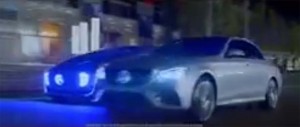Mercedes-Benz is pulling out of rotation a controversial ad for the new 2017 E-Class sedan that, critics contend, implies that the vehicle can be driven autonomously.
The issue has become particularly sensitive in the wake of a fatal crash involving a Tesla Model S sedan in Florida on May 9th. The vehicle was being operated in Tesla’s semi-autonomous Autopilot mode and, some evidence suggests, 40-year-old Joshua Brown may have been watching a video rather than remaining positioned to take control of the battery sedan in the event of a malfunction.
“The intent was never to suggest this was (an autonomous vehicle), but that this is the latest of the building blocks” that will eventually lead to self-driving technology, said Mercedes spokesperson Donna Boland, when asked about the video ad dubbed “The Future.”
(Tesla Model S operating in Autopilot mode was speeding at time of crash. Click Here for the latest.)
The first in a planned series of TV spots marking the launch of the 2017 E-Class, the video opens with images of the Mercedes-Benz F 015, a battery-powered, fully autonomous vehicle. The new E-Class eventually drives up as an announcer asks, “Is the world truly ready for a vehicle that can drive itself? Ready or not, the future is here.”
Mercedes officials point to a string of disclaimers meant to make clear that the E-Class isn’t a fully, or even semi-autonomous vehicle. In fact, the maker refers to its Drive Pilot system as “driver assist” technologies.
But the opportunity for confusion is there, critics contend. Tesla, in particular, has come under fire, not only because of the May 9 crash that killed the former Navy SEAL but two other incidents that, at least tentatively, have been blamed on Autopilot. And, some claim, the situation has been made worse by comments from Tesla CEO Elon Musk that might be seen to suggest Autopilot allows hands-free driving.
Tesla insists that is not the case, but there have been numerous examples of owners pushing the limits, one YouTube video showing a Model S driver activating Autopilot and then climbing into the backseat.
That has led from some, including California’s non-profit Consumer Watchdog, as well as the influential Consumer Reports magazine, to have Tesla disable, or at least rename, Autopilot. Some would like to see Mercedes similarly change the name of Driver Pilot because of the possible intimation of autonomous capabilities.
“Our goal has been accident-free driving, not autonomous driving,” said Mercedes’ Boland.
That echoes the position of Mark Rosekind, the director of the National Highway Traffic Safety Administration, as well as his boss, Department of Transportation Secretary Anthony Foxx. Both are strong proponents of smart safety systems, with a goal of eventually reaching true autonomous driving as a way to sharply reduce U.S. highway fatalities.
The problem is that current technologies still require hands-on-the-wheel, at least for all but the briefest of moments. And, even then, drivers need to be positioned to instantly regain control. In the case of the May Tesla crash, the camera on the Model S Autopilot system confused a white truck with a bright Florida sky. The backup radar system thought the truck was an overhead sign.
The Mercedes Drive Pilot system has at least some additional safeguards compared to Tesla’s Autopilot. It’s auto-passing system, activated by using the turn signals, will only work on specific, limited access roadways, for example.
Such safeguards are likely to become the norm. General Motors, for example, will use a similar “geo-fencing” system on its Super Cruise system when that is launched on the Cadillac CT6 sedan, likely late in 2017. Meanwhile, there will also be a retinal monitoring system that will deactivate Super Cruise if the driver isn’t alert and paying attention to the road.
(For more on Super Cruise, Click Here.)
“Correct or not,” said Mercedes spokesperson Boland, the automaker will respond to criticism of “The Future” by pulling the video out of its rotation. It will now shift to a retail-focused spot about the 2017 E-Class.
The environment has clearly changed since the Tesla crash, she added, and that will be something Mercedes must consider as it plans future ads for vehicles with advanced driving features. “In advertising, you always have to evaluate the environment into which you’re putting out the ad.”
(Apple brings back tech guru to run its secret car program. Click Here for the latest.)

